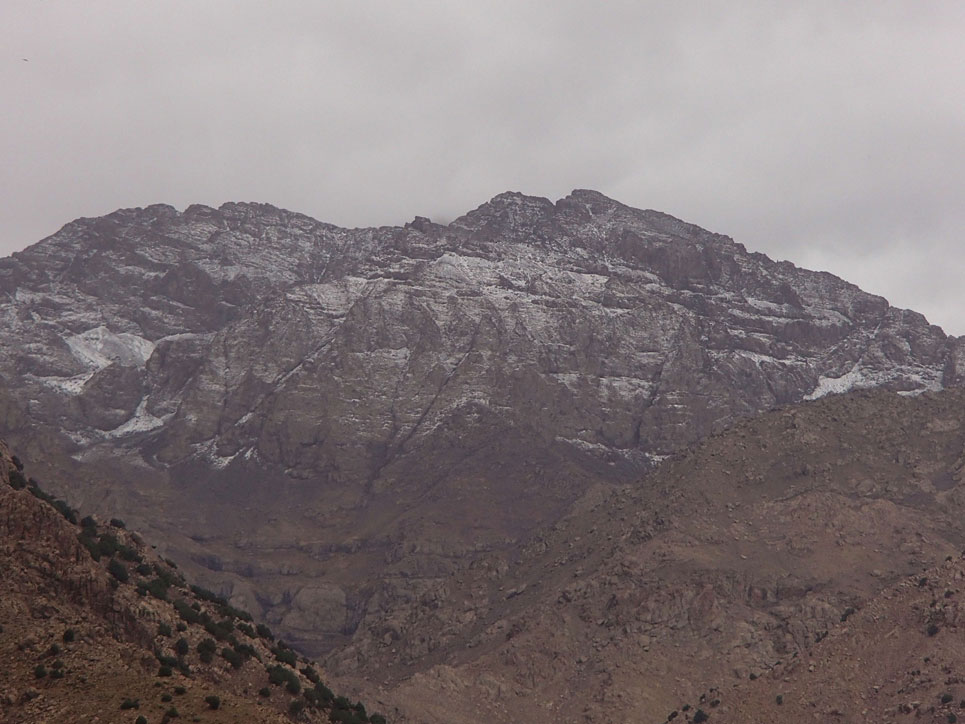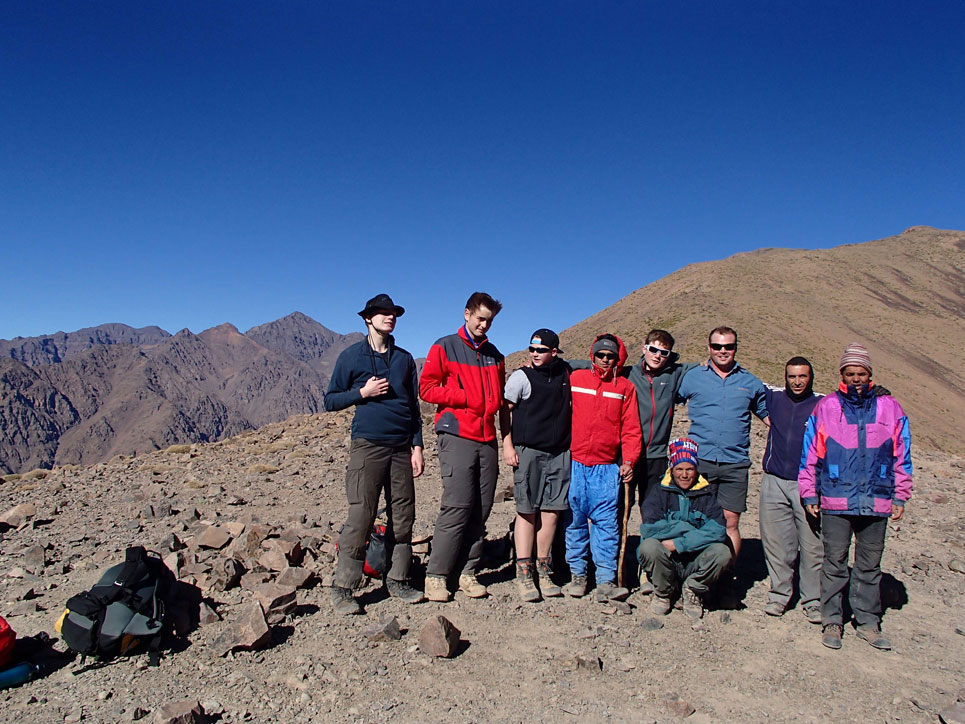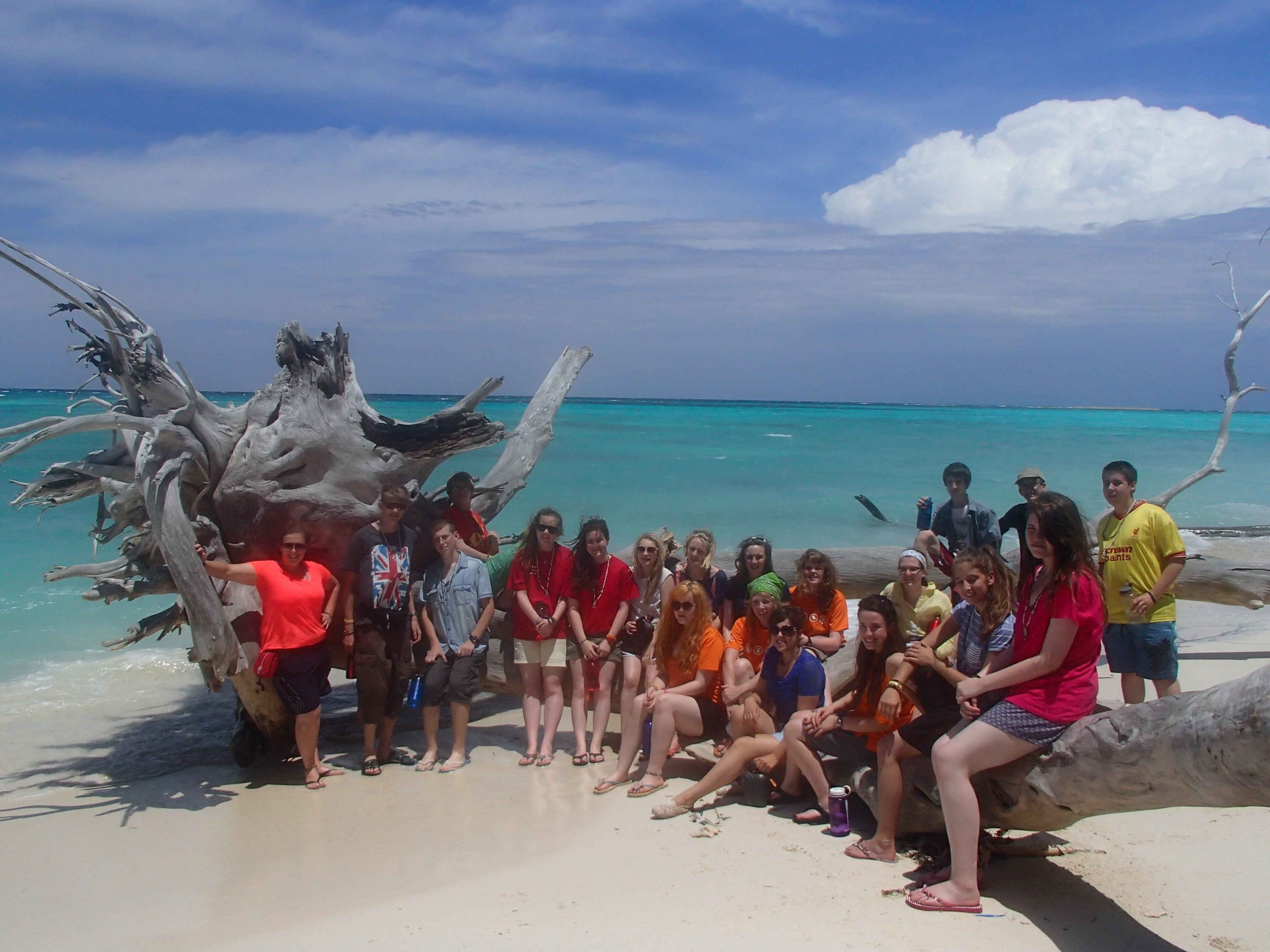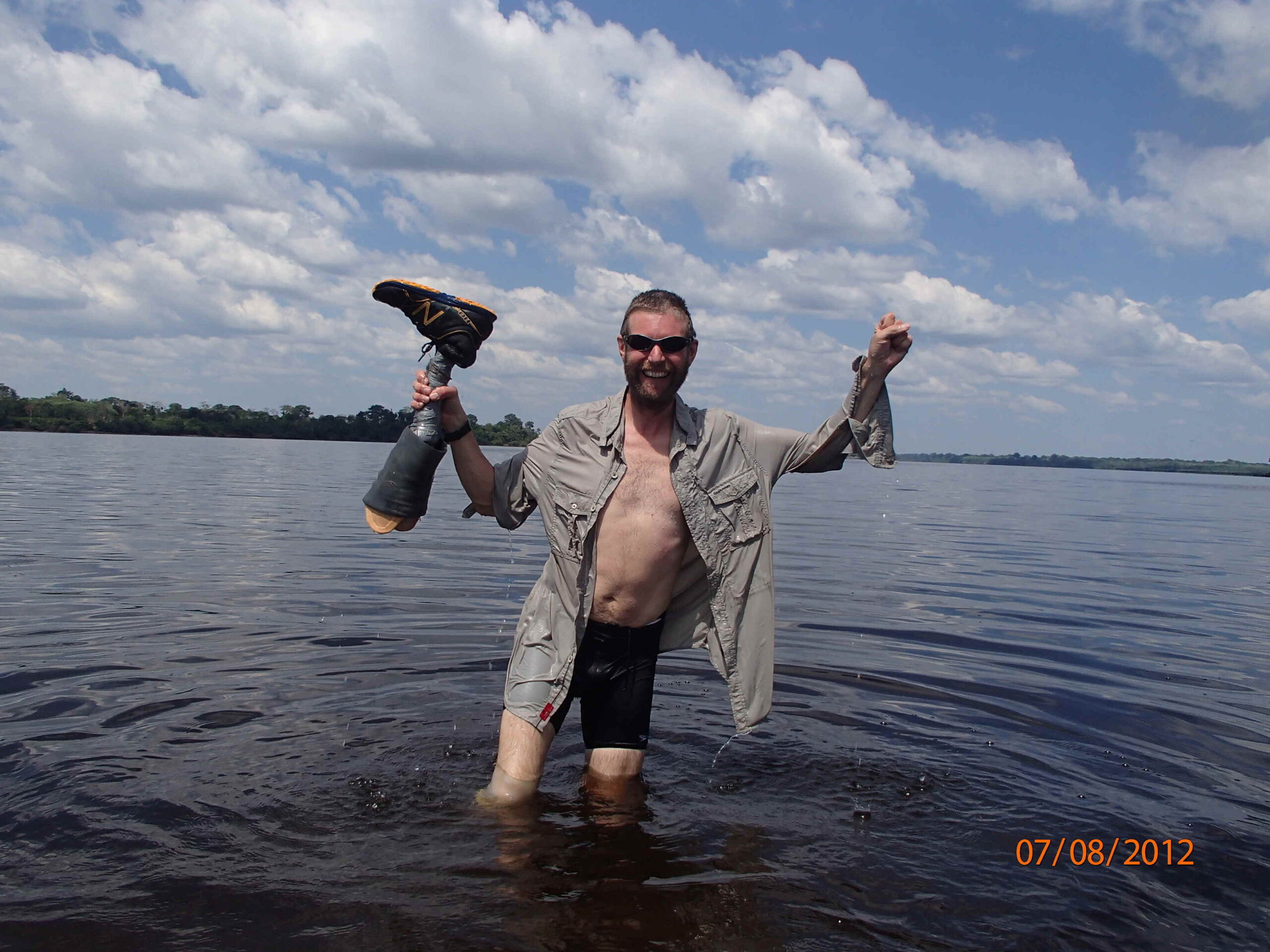
This is the kind of post that makes me happy! A truly heartwarming story of how adversity has ended up shaping not only a very different future for one couple but has also resulted in benefitting people with disabilities.
We were contacted by Catriona Jones who, with her partner Andy, has started offering accessible holidays on the beautiful island of Kos. Their venture has arisen as a result of their own physical battles; Andy became an amputee after being run over by a stolen car while riding his motorbike and Cat recently had to undergo an emergency hip replacement. When they decided to make Kos their permanent home, it quickly became apparent that facilities for people with disabilities were few and far between and following a lot of planning and some very hard work, Mobility Hire Kos and Delphini Studios, designed with people with limited mobility and wheelchair users in mind, were born. As with all the best support for people with disabilities, everything about both ventures has been informed by Cat and Andy’s personal experiences combined with their enthusiasm for the project and the love of their Greek island home.
Below Cat tells the story of how she and Andy made their brave decision and how that has led them to what they are now able to offer their guests…
Our story…..so far
Andy and I met nine years ago. We had chatted a few times before we met and when we decided to meet up Andy became concerned because he hadn’t told me he was an amputee, everyone reacts differently. He said “there’s something I need to tell you – I’m an amputee, I lost my leg below the knee after a stolen car ran me down on my motorbike” and I just said something like “Ok, no problem, my late husband was an above knee amputee, you’re still Andy, it doesn’t change anything” and the rest is history, although my Dad jokingly asked me if I had a fetish for men with one leg?!
 Andy had been a regular visitor to Kos for many years, becoming an accomplished windsurfer but when he lost his leg he was told he would never windsurf alongside his son as he used to before the accident………..and he’s accomplished again but to his credit he never lost hope. With lots of encouragement and grit determination, with the help and support from Pace Rehabilitation in Bredbury and friends at Kefalos Windsurfing and Sailing Centre on Kos Andy got back on the board and now uses a special foot for windsurfing which gives him more flexibility. Andy’s aim was to be able to windsurf alongside his son as he used to before the accident………and he’s accomplished this. It’s great to see them sailing together on the water.
Andy had been a regular visitor to Kos for many years, becoming an accomplished windsurfer but when he lost his leg he was told he would never windsurf alongside his son as he used to before the accident………..and he’s accomplished again but to his credit he never lost hope. With lots of encouragement and grit determination, with the help and support from Pace Rehabilitation in Bredbury and friends at Kefalos Windsurfing and Sailing Centre on Kos Andy got back on the board and now uses a special foot for windsurfing which gives him more flexibility. Andy’s aim was to be able to windsurf alongside his son as he used to before the accident………and he’s accomplished this. It’s great to see them sailing together on the water.
Andy and I both took a six-month sabbatical from work in 2012, converted an old police riot van into a campervan and drove across Europe to Kos. We had an amazing six months but when we returned to the UK and our jobs we were different people, our time away had changed us, changed our perspective on life and now we had changed the question in our heads about spending more time doing the things we loved from “Can we do this?” to “How can we do this?”
We worked it out and as time moved on and we spent more and more time in Greece.
During the summer of 2015 I developed a serious problem with my right hip, doctors suspected that my already mildly arthritic joint had become infected causing the joint to collapse, leaving me unable to walk. I required an emergency hip replacement. This was scheduled for November in Athens. Disaster struck while we were preparing to travel to Athens and Andy fell in the garden, wrenching his prosthetic leg off and causing soft tissue damage and swelling so he couldn’t wear his leg! Andy usually does so well on his leg that we only travel with crutches, but it quickly became apparent that he needed a wheelchair – easier said than done. We finally located one to hire on the island, but it came with two broken wheels and a flat tyre – Andy had to spend 2 hours repairing it before it was safe to use!
While I was in recovery from my operation I began thinking about the problems facing people with disabilities who wanted to visit our beautiful island…….I’d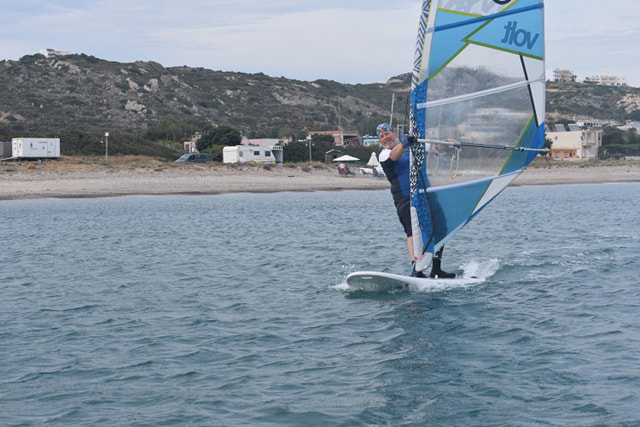 grown up helping my Mum cope with MS and with our combined experience of living with disability we hoped we had a lot to offer…….and that’s where it all began!
grown up helping my Mum cope with MS and with our combined experience of living with disability we hoped we had a lot to offer…….and that’s where it all began!
Our aim was to make Kos more accessible to more people and give them the freedom to do and see more on their holiday. We believe that life is too short not to enjoy yourselves and you shouldn’t be limited by any disability. It doesn’t matter if you’re a regular user of mobility aids or you just want an easier life on holiday, we wanted to help.
Three years ago, we began Mobility Hire Kos, hiring mobility equipment to holidaymakers and locals. We’ve met and helped some lovely people and we know from our feedback that we’re making a difference to people’s lives.
Over the last two years we’ve been asked many times about accessible rooms and studios across the island and while many advertise themselves as ‘disabled friendly’ the reality is often disappointing……and so once again we started to think!
With our first-hand experience of living with disabilities we understand many of the issues faced by people with injuries, disabilities or just recovering from surgery or illness. We understand the issues faced by people with limb loss or serious limb injury, whether they are post-op, in transition, rehabilitation or adjusting to life with a prosthetic limb. Some want privacy, others just want an environment where they can rest, relax and recuperate.
In May 2019 we are opening three specially designed private ground floor studios, adapted for travellers with restricted mobility (not just wheelchair users!)
We’ve set out to offer somewhere that allows people to have a holiday or recuperate in surroundings that don’t make life a chore!
The studios are set in a charming olive grove in the heart of Kamari Bay in Kefalos on the beautiful island of Kos in Greece with a central location, just 250m from the beach – perfect for getting away from it all!
The studios are wheelchair friendly with non-slip tiles throughout. We know the importance of safety and comfort and every area of the studios has been designed with thought, care and consideration of the needs of disabled travelers, including the full wheel-in wet-rooms.
We also offer a selection of services that will make life easier, such as Laundry Service, Take-away food, Supermarket Delivery Service.
The work to convert the studios from three very dilapidated small studios into Delphini Studios has been challenging at times. We have been very much hands-on, and Andy hasn’t just project managed the whole process he’s done a lot of the work, constantly surprising friends and workers who often forget he’s only got one leg!!
When we’re not working on the property or managing the business and on days when the wind isn’t ‘good’ for windsurfing Andy likes to snorkel and go spear fishing for octopus in the beautiful clear blue waters of the Aegean Sea, which I cook and pickle or we give to local restaurants! Some days we go fishing or take our quad bike out for a spin and explore deserted beaches around the island. We also have a large vegetable plot, chickens and two dogs! Life isn’t boring!!
Pace Rehabilitation in Bredbury worked closely with Andy to develop separate interchangeable feet (using a ferrule coupling system) so he can have separate feet for different activities, windsurfing, swimming, sailing……..when we travel, he often takes more feet with him than I take shoes!!
Kos is known as ‘the windy island’ which makes Kefalos one of the best places to windsurf in Greece. The wind is quieter in the mornings making it ideal for beginners. If anyone visiting us in Kefalos is interested in trying water sports we can arrange taster sessions or lessons in Windsurfing, Stand Up Paddle (or sit down/lie down!) and Catamaran Sailing, and although ‘one leg Andy’ (as he’s known locally) isn’t a trainer he will happily lend a guiding hand to get you started, having overcome many difficulties on the water himself.
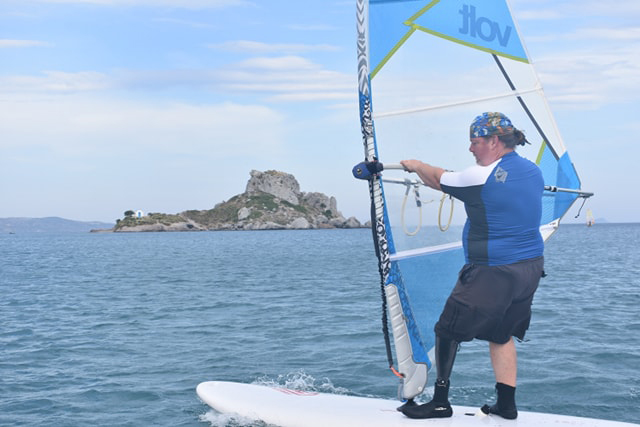
Kefalos is a beautiful village on the southwest tip of Kos island, about 42 km away from Kos town and 16 km away from the International Airport “Hippocrates”. The village is separated into two parts, the traditional village situated on the hilltop and the waterfront and harbour, Kamari Bay. Opposite Kamari Bay is the small island of Kastri with the church of St. Nicholas, one of the most photographed and iconic landmarks of the island. Kefalos village has many different architectures and houses squeezed along narrow streets, alongside traditional coffee houses and shops.
Kamari Bay is the seaside and harbour of Kefalos. There are many traditional tavernas and bars, many offering entertainment to suit everyone, from Open Mike nights to traditional Greek nights. The bay also has shops and supermarkets to explore. Kefalos is famous for its many beautiful beaches, among the best in Greece and Europe, often awarded with Blue Flags. Apart from its idyllic beaches, Kefalos is of significant archaeological interest and historical, value. The Castle of Kefalos, dating back to the Byzantine era and Early Christian churches (5th & 6th century) at St. Stephen, are only some of the area’s findings.There are local fishing trips, sunset beach BBQ trips and a visit to one of the local Traditional Houses in Kefalos is a must, it will offer an insight into the traditions of Greek life and hospitality, you then enjoy the flavours and tastes of Kos with a traditional Greek meal and if you return hungry then you’ve gone to the wrong place!!
There’s something for everyone………..
(Catriona Jones)
We’re very grateful to Cat and Andy for sharing their inspiring story and for creating what looks like the most wonderful holiday set up – they seem to have thought of everything. Please contact them using the links below if you’d like to find out more or to talk about booking a holiday with them. If you do – have a wonderful time!
Links (will open in separate tabs):
- Delphini Studios: https://delphinistudios.com/index.html
- Mobility Hire Kos Facebook Page: https://www.facebook.com/pg/MobilityHireKos/reviews/?ref=page_internal
Contact Details:




